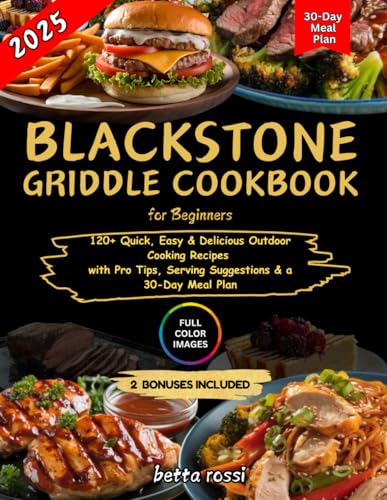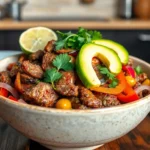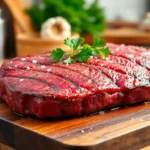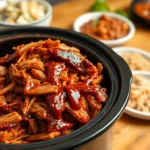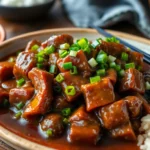We’ve discovered one of the most underrated cuts of beef that transforms into pure comfort food magic – beef neck bones. These budget-friendly bones pack incredible flavor and create the most satisfying, soul-warming meals you’ll ever taste. While many home cooks overlook this humble cut, we’re here to show you why beef neck bones deserve a permanent spot in your recipe rotation.
Rich in collagen and marrow, beef neck bones become incredibly tender when slow-cooked, releasing deep beefy flavors that’ll make your kitchen smell absolutely divine. They’re perfect for hearty stews, savory broths, and traditional comfort dishes that feed both body and soul.
What makes this recipe even better? Beef neck bones are incredibly affordable compared to premium cuts, yet they deliver restaurant-quality results when prepared correctly. We’ll guide you through our foolproof method that turns these economical bones into a mouthwatering masterpiece that’ll have your family asking for seconds every single time.
Ingredients
Our carefully selected ingredients transform humble beef neck bones into a deeply satisfying meal that rivals any expensive restaurant dish. We’ve organized these components into three essential categories to ensure perfect preparation.
For the Beef Neck Bones
- 3 to 4 pounds beef neck bones, cut into 2-inch pieces
- 2 tablespoons vegetable oil for browning
- 1 tablespoon tomato paste for color and depth
For the Seasonings and Aromatics
- 2 teaspoons kosher salt
- 1 teaspoon black pepper, freshly ground
- 1 teaspoon garlic powder
- 1/2 teaspoon smoked paprika
- 1/2 teaspoon dried thyme
- 2 bay leaves
- 4 garlic cloves, minced
- 1 medium yellow onion, diced
- 6 cups beef broth, low sodium
- 1 cup red wine (optional but recommended)
For the Vegetables
- 3 large carrots, cut into 1-inch pieces
- 3 celery stalks, chopped
- 1 pound baby potatoes, halved
- 8 ounces mushrooms, quartered
- 2 tablespoons fresh parsley, chopped for garnish
Equipment Needed

Creating perfectly tender beef neck bones requires the right tools to handle this tougher cut of meat. We’ve compiled a comprehensive list of essential equipment that will ensure your braising process delivers restaurant-quality results every time.
Essential Cooking Vessels
Dutch Oven or Heavy Pot – This serves as our primary braising vessel for stovetop cooking. The heavy bottom distributes heat evenly while the tight-fitting lid traps moisture and steam. Cast iron or enameled cast iron works exceptionally well for maintaining consistent temperatures throughout the long cooking process.
Large Skillet or Frying Pan – We use this for the crucial browning step that develops deep flavors. A heavy-bottomed skillet prevents hot spots and ensures even searing across all surfaces of the neck bones.
Oven-Safe Baking Dish or Casserole Dish – For oven-braised preparations, we recommend a dish that can accommodate 3 to 4 pounds of neck bones comfortably. The dish should have high sides to prevent spillage and a tight-fitting lid or heavy-duty aluminum foil for covering.
Alternative Cooking Methods
Slow Cooker – This appliance offers hands-off convenience for busy schedules. We can brown the bones separately and transfer them to the slow cooker for 6 to 8 hours of gentle cooking on low heat.
Instant Pot or Pressure Cooker – Modern pressure cooking significantly reduces cooking time while maintaining the tender results we expect from traditional braising methods.
Essential Utensils and Tools
Wooden Spoon or Heat-Resistant Spatula – These tools help us deglaze the pan effectively and scrape up those flavorful browned bits that enhance our braising liquid.
Whisk – We need this for creating smooth gravies from pan drippings and ensuring our seasonings distribute evenly throughout the cooking liquid.
Mixing Bowls – Various sizes accommodate our ingredients during preparation and keep our workspace organized.
Measuring Cups and Spoons – Precise measurements ensure consistent results every time we prepare this recipe.
Preparation Tools
Sharp Chef’s Knife – We use this for chopping vegetables and trimming any excess fat from the neck bones before cooking.
Cutting Board – A sturdy surface protects our countertops and provides safe space for ingredient preparation.
Tongs – These allow us to safely turn and move the neck bones during the browning process without piercing the meat.
Having these tools readily available streamlines our cooking process and ensures we can focus on developing the rich flavors that make beef neck bones so satisfying.
Prep Work

Proper preparation sets the foundation for achieving restaurant-quality results with beef neck bones. We’ll walk through three essential prep steps to maximize flavor and ensure tender, succulent meat.
Preparing the Neck Bones
We start by cleaning the neck bones thoroughly and removing any excess fat for a cleaner and less greasy dish. Pat the neck bones dry using paper towels and season generously with salt and pepper to enhance the natural beef flavor.
Heat olive oil or vegetable oil in our heavy skillet or Dutch oven over medium-high heat. Brown the neck bones on all sides until a golden crust forms. This searing process locks in juices and builds the foundation of flavor we’re looking for. We work in batches to avoid overcrowding the pan and ensure even browning on each piece.
Preparing the Vegetables
We chop our key aromatics including onions, carrots, and celery to create a foundational flavor base for our dish. After removing the browned neck bones, we add the chopped vegetables to the same pan and sauté for 5-6 minutes until the edges start to brown.
This caramelization process deepens the overall flavor profile significantly. We then add garlic and ginger along with any additional aromatics and cook for another 1-2 minutes to release their aromatic compounds into our cooking base.
Making the Seasoning Mix
Our typical seasoning blend includes salt, pepper, paprika, allspice, and herbs like bay leaves or fresh parsley for complexity. We add tomato paste to the sautéed vegetables and cook it through to develop richness and slight acidity.
To deglaze the pan and capture all those flavorful browned bits from searing, we add a splash of liquid such as red wine or pomegranate juice. We scrape the bottom with a wooden spoon to incorporate these concentrated flavors. Finally, we add beef broth or stock and return the neck bones to the pot along with our remaining herbs and spices. The mixture will then simmer on low heat for 4-6 hours until the beef becomes fork-tender and falls off the bone.
Instructions

Now we’ll walk through the cooking process step by step to transform these humble neck bones into a tender, flavorful masterpiece. Each stage builds upon the previous one to create layers of rich, complex flavors.
Browning the Neck Bones
We begin by patting the neck bones completely dry with paper towels. Season all sides generously with salt and pepper, ensuring every surface is covered. Heat 2 tablespoons of vegetable oil in our large skillet over medium-high heat until it shimmers.
Carefully place the neck bones in the hot oil without overcrowding the pan. Brown each side for approximately 5 minutes, turning with tongs to achieve an even golden-brown crust on all surfaces. The caramelization process locks in juices and develops the deep, rich flavors that form the foundation of our dish.
Transfer the browned neck bones to a large plate and set aside while we build our flavor base.
Building the Base
Using the same skillet with the flavorful drippings, add our diced onions, carrots, and celery. Sauté the vegetables for 3 to 5 minutes until they begin to soften and release their aromatic oils. The vegetables will pick up the caramelized bits from the bottom of the pan, adding another layer of flavor.
Stir in the minced garlic and cook for an additional 30 seconds until fragrant. Add the tomato paste and mix thoroughly, cooking for 1 minute to develop its rich flavor. Sprinkle in the paprika, allspice, salt, and pepper, stirring constantly to prevent burning.
Pour in a splash of red wine if using, scraping the bottom of the pan with our wooden spoon to release any browned bits. These caramelized pieces contain concentrated flavor that enriches our entire dish.
Adding Liquids and Seasonings
Return the browned neck bones to the skillet along with any accumulated juices. Pour the beef broth over the bones, ensuring they are mostly covered with liquid. Add the bay leaves and dried thyme, distributing them evenly throughout the mixture.
Taste the liquid and adjust seasoning with additional salt and pepper as needed. The broth should be well-seasoned at this stage since it will concentrate during the long cooking process.
Bring the mixture to a gentle simmer, then reduce heat to maintain a steady, low bubble.
Slow Cooking Process
| Cooking Method | Temperature | Time | Key Points |
|---|---|---|---|
| Stovetop | Low simmer | 4-6 hours | Maintain gentle bubble |
| Oven | 275°F (135°C) | 4-6 hours | Cover tightly |
| Slow Cooker | Low setting | 6-8 hours | Set and forget convenience |
Cover the skillet tightly with a lid or transfer everything to our Dutch oven for oven braising. The long, slow cooking process breaks down the tough connective tissues and transforms the collagen into gelatin, creating a naturally thick, rich gravy.
Check the neck bones every hour, adding more broth if needed to maintain liquid levels. The meat is ready when it easily pulls away from the bones with a fork. During the final 30 minutes, we can mix a tablespoon of flour with cold water to create a slurry if we prefer a thicker gravy consistency.
Remove the bay leaves before serving, and taste once more for final seasoning adjustments.
Cooking Methods

We’ll explore three proven techniques for cooking beef neck bones that deliver restaurant-quality results. Each method offers unique advantages depending on your available time and preferred cooking style.
Stovetop Method
We start by maintaining medium-high heat in our heavy-bottomed pot throughout the searing process. The neck bones require 1-2 minutes per side to develop that crucial golden-brown crust that locks in flavor. Once we’ve achieved proper browning, we remove the bones and sauté our aromatics in the same pot.
Our vegetable base begins with onions, garlic, carrots, and celery cooked until softened and fragrant. We add tomato paste next, stirring constantly for 1-2 minutes to eliminate any raw taste. Red wine or beef stock works perfectly for deglazing, allowing us to scrape up those valuable browned bits from the bottom.
The neck bones return to the pot covered with beef stock or water, creating the perfect braising environment. We bring the mixture to a rolling boil before reducing heat to maintain a gentle simmer. Fresh thyme and bay leaves enhance the aromatic profile as we cover and cook for 2-4 hours until the meat falls effortlessly off the bone.
Oven Braising Method
We preheat our oven to 325°F while preparing the neck bones on the stovetop. Our Dutch oven serves double duty, moving seamlessly from stovetop searing to oven braising without transferring ingredients.
The searing process remains identical to stovetop preparation, creating that essential caramelized exterior. We remove the browned bones and build our flavor base with sautéed onions and garlic in the same vessel. Tomato paste, thyme, and pepper get stirred in briefly before we deglaze with red wine.
Once we return the neck bones to the pot, we add enough beef stock to partially submerge the meat. A tight-fitting lid or aluminum foil creates the sealed environment necessary for proper braising. The oven maintains consistent heat for 2.5-4 hours, producing fork-tender results with minimal hands-on attention.
Slow Cooker Method
We begin by cleaning our neck bones thoroughly and removing excess fat for optimal results. A quick sauté of garlic and onions in a skillet develops foundational flavors before everything transfers to the slow cooker.
The neck bones, sautéed aromatics, and seasonings all combine in the slow cooker with enough beef stock to create proper moisture levels. High heat setting requires approximately 4 hours, while low heat extends cooking time to 6-8 hours for similar tenderness.
This set-and-forget approach offers maximum convenience while delivering consistently tender meat. We achieve the same fall-off-the-bone texture with significantly less active cooking time, making this method ideal for busy schedules.
Make-Ahead Instructions

Beef neck bones adapt perfectly to meal prep strategies that help busy households enjoy rich flavors without extensive daily cooking. We recommend preparing components in advance to streamline the cooking process and enhance the final dish’s depth.
Cleaning and Seasoning Preparation
Begin by cleaning the neck bones thoroughly under cold running water. Pat them completely dry with paper towels before applying your chosen seasoning blend. Our preferred combination includes kosher salt, black pepper, paprika, cumin, and garlic powder. Store the seasoned bones in an airtight container in the refrigerator for up to 24 hours. This advance preparation allows the seasonings to penetrate the meat and develop more complex flavors.
Browning Components
Brown the neck bones in batches using vegetable oil or bacon fat until they develop a golden crust on all surfaces. Allow the browned bones to cool completely before transferring them to storage containers. Prepare your aromatics by chopping onions, carrots, celery, and garlic into uniform pieces. Store the browned bones and prepared vegetables separately in the refrigerator for up to two days.
Complete Assembly Method
Layer all ingredients directly in your Dutch oven or slow cooker for maximum convenience. Place the browned neck bones in the bottom, add the prepared aromatics, and pour in the liquid components including beef stock, tomato paste, and red wine. Cover tightly and refrigerate the assembled dish for up to 24 hours or freeze for up to three months.
Cooking from Prepared State
Remove refrigerated assembled dishes 30 minutes before cooking to bring closer to room temperature. Add an additional 30 minutes to the cooking time when starting from cold. Frozen preparations require thawing overnight in the refrigerator before proceeding with the standard cooking method. This approach ensures even heat distribution and optimal texture development.
Storage and Reheating Guidelines
| Storage Method | Duration | Reheating Instructions |
|---|---|---|
| Refrigerated cooked bones | 3-4 days | Reheat gently over low heat for 15-20 minutes |
| Frozen cooked bones | 2-3 months | Thaw overnight, then reheat as refrigerated |
| Gravy separation | Store separately | Reheat and whisk to recombine |
Store leftover cooked beef neck bones with their cooking liquid to prevent the meat from drying out. The natural gelatin from the bones creates a protective coating that maintains moisture during storage. Reheat portions slowly over medium low heat, stirring occasionally to distribute the thickened gravy evenly throughout the dish.
Serving Suggestions

We transform beef neck bones into a complete comfort meal by pairing this rich and tender dish with classic sides and complementary sauces. Our carefully selected accompaniments enhance the deep flavors while creating a satisfying dining experience.
Traditional Sides
We recommend serving beef neck bones alongside collard greens for an authentic Southern soul food experience. The slightly bitter greens provide a perfect contrast to the rich marrow flavors. Mashed potatoes create an ideal canvas for soaking up the savory braising liquid while adding creamy texture to each bite.
Cornbread serves as our go-to bread option because its sweet crumbly texture balances the savory meat beautifully. We often serve white rice as another excellent base that absorbs the flavorful cooking juices. These traditional pairings have stood the test of time in Southern and soul food cuisine for good reason.
Other classic sides we enjoy include:
- Steamed or sautéed green beans
- Roasted root vegetables like carrots and parsnips
- Creamy coleslaw for textural contrast
- Mac and cheese for ultimate comfort food indulgence
Sauce and Gravy Options
We transform the rich braising liquid into an exceptional gravy that elevates the entire meal. The cooking juices contain concentrated flavors from the neck bones along with aromatics and seasonings. Simply strain the liquid and thicken it slightly with a cornstarch slurry or flour roux to create a restaurant-quality sauce.
Our mushroom variation adds earthy depth by sautéing sliced mushrooms in the same pot before deglazing. The mushrooms absorb the rich flavors while contributing their own umami notes. We sometimes incorporate cumin and allspice for a slow cooker version that brings subtle heat and warm spice complexity.
For additional flavor profiles we create:
- Red wine reduction using the deglazing liquid
- Herb-infused gravy with fresh thyme and rosemary
- Spicy variation with cayenne pepper and hot sauce
- Tomato-based sauce using the tomato paste foundation
The key lies in tasting and adjusting seasoning levels before serving to ensure our gravy complements rather than overwhelms the tender beef neck bones.
Storage and Reheating

After investing time in creating this deeply flavorful dish, we want to ensure our beef neck bones maintain their tenderness and rich taste when stored for later enjoyment. Proper storage techniques protect the meat’s quality while smart reheating methods preserve the fall-off-the-bone texture we worked so hard to achieve.
Refrigerator Storage
We recommend transferring cooled beef neck bones to airtight containers within 2 hours of cooking to maintain food safety standards. Our cooked neck bones stay fresh in the refrigerator for up to 3-4 days when stored properly. The braising liquid should be stored alongside the meat since this flavorful base enhances reheating and prevents the meat from drying out.
Freezer Storage Guidelines
Long-term storage becomes simple when we use airtight freezer-safe containers or heavy-duty freezer bags for our cooked beef neck bones. Properly packaged neck bones maintain their quality for up to 2-3 months in the freezer. We suggest portioning the meat and liquid into meal-sized containers before freezing to make thawing more convenient for future meals.
| Storage Method | Duration | Container Type |
|---|---|---|
| Refrigerator | 3-4 days | Airtight containers |
| Freezer | 2-3 months | Freezer-safe containers or heavy-duty bags |
Gentle Reheating Techniques
Stovetop reheating delivers the best results when we place the neck bones in a heavy pot over low heat with a splash of beef broth or water. This method allows us to control the temperature while maintaining moisture throughout the reheating process. We stir occasionally and heat until the internal temperature reaches 165°F for food safety.
Oven reheating works well when we cover the neck bones with foil and warm them at 325°F until heated through. Adding a few tablespoons of the original braising liquid prevents the meat from becoming dry during the gentle warming process.
Microwave reheating requires careful attention to preserve the meat’s texture. We place portions in microwave-safe dishes with tight-fitting lids and heat in 30-second intervals. Stirring between intervals and adding small amounts of broth ensures even heating without overcooking the tender meat.
These storage and reheating methods ensure our beef neck bones remain as delicious as the day we first prepared them, making this economical cut a practical choice for meal planning and busy weeknight dinners.
Recipe Variations

We’ve discovered three distinct regional approaches that transform beef neck bones into uniquely flavorful dishes. Each variation leverages different spice profiles and cooking techniques to create memorable meals.
Southern-Style Neck Bones
Our Southern approach keeps things beautifully simple while delivering maximum comfort. We brown the neck bones in oil and sauté onions and garlic until fragrant. The addition of tomato paste creates a rich base that develops deep flavor during the long braising process.
This traditional method involves simmering the neck bones in beef stock for several hours until they become fork-tender. We season generously with kosher salt and black pepper, allowing the natural beef flavors to shine through. The resulting gravy becomes thick and luxurious, perfect for spooning over rice or sopping up with cornbread.
Southern cooks often serve these neck bones alongside collard greens and cornbread for a complete soul food experience. The slow cooking process ensures the meat falls off the bone while creating a gravy that captures all the concentrated flavors.
Caribbean-Inspired Version
We elevate beef neck bones with bold Caribbean spices that create an aromatic and fiery stew. Our version incorporates Scotch bonnet peppers for heat alongside warming spices like allspice and fresh thyme. The addition of vinegar or citrus juice provides a bright tang that balances the rich meat.
This regional variation simmers the neck bones with these bold seasonings, sometimes including beans or root vegetables for added substance. We build layers of flavor by toasting whole spices before adding liquids, creating a complex aromatic base that infuses the meat during the long cooking process.
The finished dish delivers a spicy, aromatic stew that showcases the vibrant flavors of Caribbean cuisine. We recommend serving this version with rice and beans to help tame the heat while soaking up the flavorful broth.
Asian-Style Preparation
Our Asian-inspired version transforms beef neck bones into an elegantly spiced dish using aromatic spices and unique flavor combinations. We braise the neck bones with Chinese five spice, star anise, cinnamon sticks, cardamom, cloves, and Sichuan peppercorns for a complex flavor profile.
The cooking liquid combines beef broth with pomegranate juice, creating a unique base that develops into a rich, fruity undertone. We add fresh ginger, garlic, and oyster sauce to build umami depth while the aromatic spices infuse the meat during the slow braising process.
This preparation finishes with a pomegranate glaze that adds sweetness and visual appeal to the tender neck bones. We serve this fragrant dish over steamed rice, allowing the complex flavors to shine while providing a satisfying contrast to the rich, fall-off-the-bone meat.
Tips for Success

Achieving perfectly tender beef neck bones requires patience and attention to detail. We’ve compiled these essential tips to help you master this economical cut and create restaurant-quality results every time.
Temperature Control Makes the Difference
Maintaining consistent low heat transforms tough neck bones into succulent meat. We recommend keeping your braising liquid at a gentle simmer rather than a rolling boil. High heat causes the meat fibers to tighten and become chewy. Monitor your cooking temperature carefully whether using stovetop, oven, or slow cooker methods.
Proper Searing Creates Flavor Foundation
Brown your neck bones thoroughly on all sides before braising. This caramelization process develops deep flavors that permeate the entire dish. Don’t overcrowd the pan during searing as this creates steam instead of the desired golden crust. Work in batches if necessary to achieve proper browning.
Liquid Levels Require Monitoring
Check your braising liquid periodically during the long cooking process. The neck bones should remain partially covered throughout cooking to prevent drying out. Add warm beef stock or broth as needed to maintain proper liquid levels. Cold liquid can shock the meat and interrupt the cooking process.
Timing Varies by Size and Method
Cooking times depend on the size of your neck bones and chosen cooking method. Smaller bones may become tender in 2.5 hours while larger pieces require up to 4 hours. Test doneness by checking if the meat easily pulls away from the bone with a fork. Don’t rush this process as undercooking results in tough, chewy meat.
Seasoning Adjustments Enhance Final Results
Taste your braising liquid during the final hour of cooking and adjust seasonings accordingly. The long cooking process can mellow flavors so additional salt, pepper, or herbs may be necessary. Remove bay leaves before serving and consider adding fresh herbs for brightness.
Resting Improves Texture and Flavor
Allow your finished neck bones to rest for 10-15 minutes before serving. This resting period lets the meat reabsorb juices and ensures maximum tenderness. The braising liquid will also thicken slightly during this time, creating a more cohesive sauce.
Conclusion
We’ve shown you that beef neck bones aren’t just budget-friendly—they’re a gateway to incredibly rich and satisfying meals. With the right techniques and a bit of patience you can transform this humble cut into something that rivals expensive restaurant dishes.
Whether you choose stovetop braising oven cooking or the convenience of a slow cooker the key is low and slow cooking. Don’t forget to experiment with our regional variations to keep your meals exciting and diverse.
These techniques will help you master beef neck bones and create memorable family dinners without very costly. Your kitchen will smell amazing and your family will be asking for seconds every time.
Frequently Asked Questions
What are beef neck bones and why should I cook with them?
Beef neck bones are an underrated, budget-friendly cut that’s rich in collagen and marrow. When slow-cooked, they become incredibly tender and release deep, complex flavors. They’re perfect for creating restaurant-quality stews and broths at an affordable price, making them an excellent choice for economical yet satisfying meals.
How long does it take to cook beef neck bones?
Beef neck bones require 4-8 hours of cooking time depending on your method. Stovetop simmering and oven braising typically take 4-6 hours, while slow cooking can take 6-8 hours. The key is low, slow cooking until the meat becomes fork-tender and falls off the bone.
What equipment do I need to cook beef neck bones?
Essential equipment includes a Dutch oven or heavy pot for braising, a large skillet for browning, and basic utensils like a wooden spoon, tongs, and sharp knife. Alternative methods can use a slow cooker or Instant Pot for convenience. An oven-safe baking dish works for oven braising.
What ingredients pair well with beef neck bones?
Key ingredients include aromatic vegetables like onions, carrots, and celery, plus seasonings such as garlic, bay leaves, thyme, and paprika. Tomato paste adds depth, while beef broth provides the cooking liquid. Red wine or pomegranate juice can be used for deglazing to enhance flavors.
Can I make beef neck bones ahead of time?
Yes, beef neck bones are excellent for meal prep. You can clean and season them up to two days in advance, brown them ahead of time, or fully assemble ingredients for later cooking. Cooked neck bones store well in the refrigerator for 3-4 days or freeze for 2-3 months.
What are the best cooking methods for beef neck bones?
Three proven methods work best: stovetop simmering, oven braising, and slow cooking. Stovetop offers more control, oven braising provides consistent heat, and slow cooking is convenient for busy schedules. All methods require browning the bones first to develop flavor and achieve tender results.
What should I serve with beef neck bones?
Traditional sides include mashed potatoes, collard greens, cornbread, and white rice. The rich braising liquid makes an excellent gravy. Other great options include roasted root vegetables, green beans, mac and cheese, or coleslaw to balance the rich, hearty flavors of the dish.
How do I store and reheat leftover beef neck bones?
Store cooled neck bones in airtight containers in the refrigerator for 3-4 days or freeze for 2-3 months. Reheat gently on the stovetop with a splash of broth, in a 325°F oven covered with foil, or in the microwave at 50% power to maintain tenderness and prevent drying out.
Are there different ways to prepare beef neck bones?
Yes, beef neck bones are versatile and can be prepared in various regional styles. Southern-style features rich gravy, Caribbean-inspired versions include bold spices and heat, while Asian-style preparations use aromatic spices and unique cooking liquids. Each variation offers distinct flavors while maintaining the tender, comforting qualities.
What’s the key to perfectly tender beef neck bones?
Success depends on proper browning for flavor development, maintaining a gentle simmer (not a rolling boil), monitoring liquid levels to prevent drying, and allowing adequate cooking time. The meat should be fork-tender and falling off the bone when properly cooked. Temperature control is crucial for achieving the best results.






















